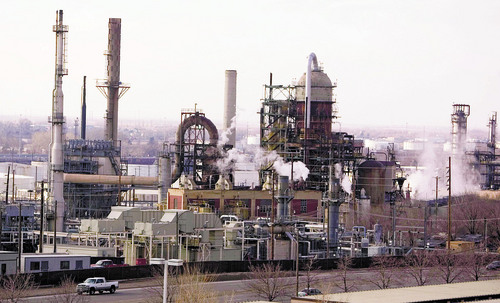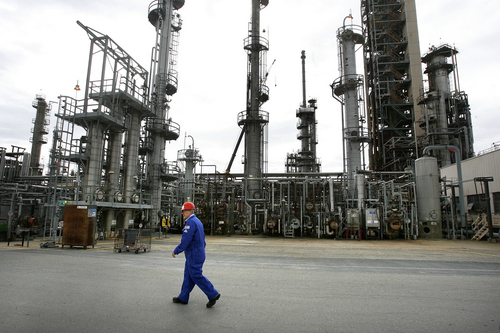This is an archived article that was published on sltrib.com in 2014, and information in the article may be outdated. It is provided only for personal research purposes and may not be reprinted.
After a contentious public meeting Wednesday, Utah air quality officials sewed up a comprehensive road map to reduce the Salt Lake Valley's air pollution to acceptable levels — even though the U.S. Environmental Protection Agency says the plan's emission limits remain too soft on industrial polluters.
The sections of the state implementation plan, or SIP, approved Wednesday limit how much fine particulate matter, or PM2.5, and its chemical precursors oil refineries and other industrial pollution sources may emit. But the plan would exempt pollution these industries release when their equipment is malfunctioning or in startup or shutdown modes, periods when they spew far more pollution than when they are operating normally.
That was just one of many issues critics pointed out to the Utah Air Quality Board in asking it to reject the plan until it can be strengthened. Some activists accused state officials of allowing the Wasatch Front to become a "corporate sacrifice zone." Others said the plan fails to hold industry to the same standards expected of residents and smaller businesses.
Still, Division of Air Quality (DAQ) director Bryce Bird sees an environmental upside to setting the plan's emission limits now. Such a move enables regulators to review new permit applications under the lower emission limits and tougher rules. It also prevents industrial polluters from "banking" reductions they voluntarily make before new requirements go into effect, which they can later use to offset future emissions.
The board approved the plan on a 6-1 vote, with Robert Paine, a University of Utah physician, casting the nay vote.
"They are ultimately saying the right to pollute trumps the right to breathe clean air," said Cherise Udell of Utah Moms for Clean Air.
The DAQ did revise its draft air quality plan in response to many of the EPA's recommendations, made in 64 pages of comments, but it retained the controversial exemption with the promise to fix it later when another version of the plan is due.
"Under EPA's latest guidance we can't exempt startups and malfunctions, but we can put a separate [emission] limit on them," Bird said.
EPA officials said Utah's particulate pollution is a serious problem demanding "aggressive steps" to cut emissions from all sources.
"We will continue to work with [Utah] DAQ to address these concerns in final plans submitted for EPA's approval. Our goal is to secure final plans this year that will deliver much needed air quality improvements to Utah's citizens," EPA spokesman Rich Mylott said in an e-mail.
The feds' comments echo what Utah clean-air activists have been advocating for years: The state should get tougher on industrial polluters, even though regulators estimate industry accounts for about 12 percent of Salt Lake's air pollution.
"It's true industry isn't the biggest source, but it's the one the state has the most authority over," said Matt Pacenza, policy director for HEAL Utah.
"Utahns are desperate to see urgent action to help clean our air," Pacenza added. "We need the best plan we can possibly get, which means requiring the valley's biggest polluters to do as soon as possible what others around the country have done – reduce their emissions using the best available technologies."
According to DAQ, however, Utah industries will spend about $50 million a year on emission controls and process upgrades, and oil refineries have already agreed to time their unit shutdowns and startups to avoid the winter inversion season.
Pollution limits approved Wednesday will prevent 4,600 tons of annual emissions by 2019, with the state's five oil refineries accounting for 2,000 tons. But critics point out that the plan allows for an overall increase of industrial emissions by 12 percent, while relying on substantial decreases from automobiles and small businesses.
Increased emissions from just three sources — Kennecott Utah Copper's non-mining operations, US Magnesium and Nucor Steel — will increase nearly 13 tons a day between 2010 and 2019, according to data provided by DAQ. Such a load would negate any gains accomplished at the oil refineries.
In the packed meeting hall at the DAQ, some activists unsuccessfully called on board chairman Steve Sands, a Kennecott executive, and other industry representatives to abstain from voting.
HEAL and other groups insist the state should require all oil refineries use wet-gas scrubbers, electric-powered compressors, and selective catalytic reduction, or SCR, all pollution-fighting measures the Holly refinery in West Bountiful is committed to as part of its proposed expansion and agreements with the EPA.
"Since Holly is doing them, [these measures] are by definition 'reasonably available,'" Pacenza said.
Activists and EPA also contend federal law requires such controls, known as reasonably available control technologies, be installed by the end of 2013, while the state plan bends to industry's desire to wait until 2017 and beyond.
Nucor and other industrial players, meanwhile, criticize the plan for expecting emission reductions from them when they have already "done enough."
What is PM2.5?
PM2.5 refers to dangerous particles of pollutants that are less than 2.5 microns in diameter. They can lodge deep in lung tissues and are linked to diseases from cancer to asthma.
Vehicles, industry, homes and many other sources emit these particles.
But the most common sources of PM2.5 in Utah's urban valleys are the "precursor" gasses they also emit, which develop into PM2.5 through chemical reactions in the environment.









